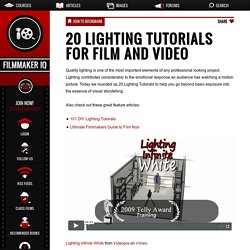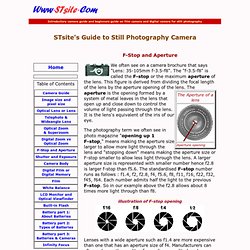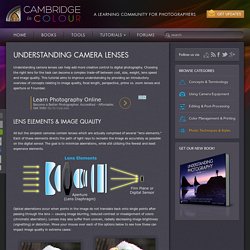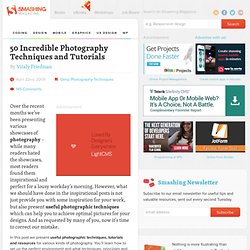

Surreal Self Portraits Update. Rare wildlife photos highlight winning entries in worldwide contest. Lomography. Lenses 101 - 1. The types of lenses. Photography and post-processing tutorials from beginner to advanced. Photography 101.org - How to Choose a Lens.
Your lens is quite possibly the most important part of your camera. SLR and dSLR (digital SLR) cameras (and even some non SLR/dSLR) allow you to change out the lenses, to suit all of your photography needs. A good lens will produce sharp crystal-clear pictures with beautiful detail. A low quality lens can hinder you to the point where you'd be better off shooting with a disposable camera. Basically, your lens makes or breaks your camera.
Different lenses have different purposes, functions, and features. The main things to look at when buying a lens are maximum aperture and focal length. One important thing to remember when selecting a lens for a digital camera with an APS-C sensor (the majority of digital SLRs on the market), is that a lens used on a digital camera will have an effectively longer focal length than if it was used on a film camera. Lens Types Different lenses have different uses. All lenses come in two varieties, Zoom and Prime. 8 Effects Every Photographer Should Know About. Photography 101 – Lenses, Light and Magnification. 20 Lighting Tutorials for Film and Video. Join To Bookmark Share Quality lighting is one of the most important elements of any professional looking project.

Lighting contributes considerably to the emotional response an audience has watching a motion picture. Today we rounded up 20 Lighting Tutorials to help you go beyond basic exposure into the essence of visual storytelling. Also check out these great feature articles: Lighting Infinite White from Videopia on Vimeo. 3 point lighting basic from LifeNow Video on Vimeo. F-Stop and Aperture, Still Photography Camera Guide stsite.com. We often see on a camera brochure that says "Lens: 35-105mm f-3.5-f8".

The "f-3.5-f8" is called the F-stop or the maximum aperture of the lens. This figure is derived from dividing the focal length of the lens by the aperture opening of the lens. The aperture is the opening formed by a system of metal leaves in the lens that open up and close down to control the volume of light passing through the lens. Fotogenetic - 35mm Film and the Golden Rectangle. Oskar Barnack and the 3:2 Aspect Ratio The origins of the aspect ratio of 35mm film can be traced to Oskar Barnack, an employee of Leitz Camera in Germany.

Barnack believed the 3:2 aspect ratio to be the ideal choice for his invention, the first 35mm camera ever, dubbed the "Ur-Leica". After WWI, Barnack convinced his boss, Ernest Leitz II, to begin production of similar cameras. Understanding Camera Lenses. Understanding camera lenses can help add more creative control to digital photography.

Choosing the right lens for the task can become a complex trade-off between cost, size, weight, lens speed and image quality. This tutorial aims to improve understanding by providing an introductory overview of concepts relating to image quality, focal length, perspective, prime vs. zoom lenses and aperture or f-number. All but the simplest cameras contain lenses which are actually comprised of several "lens elements. " Each of these elements directs the path of light rays to recreate the image as accurately as possible on the digital sensor. The goal is to minimize aberrations, while still utilizing the fewest and least expensive elements.
Optical aberrations occur when points in the image do not translate back onto single points after passing through the lens — causing image blurring, reduced contrast or misalignment of colors (chromatic aberration). Original Image. 50 Incredible Photography Techniques and Tutorials. Advertisement Over the recent months we’ve been presenting various showcases of photography – while many readers hated the showcases, most readers found them inspirational and perfect for a lousy workday’s morning.

However, what we should have done in the inspirational posts is not just provide you with some inspiration for your work, but also present useful photographic techniques which can help you to achieve optimal pictures for your designs. And as requested by many of you, now it’s time to correct our mistake. In this post we present useful photographic techniques, tutorials and resources for various kinds of photography.
You’ll learn how to set up the perfect environment and what techniques, principles and rules of thumbs you should consider when shooting your next perfect photo. 1. 35mm film photography cameras include single-lens reflex and rangefinder. EmailEmail 35mm film is by far the most common film type used in modern film photography, whether color, black and white, or reversal. As such, there are many different film cameras that support 35mm photography. Basic film photography tip and technique for exposure - Sunny 16. EmailEmail.

Black & White Film Photography - A Beginner's Primer. Beginner's Guide to Photography - Photonhead.com. 5 Film Photography Tips" It's no surprise that any photograph -- digital or film -- is going to be vastly improved by a terrific composition.

That is, no matter how excellent your equipment is or how skilled you are at wielding it, the subject still won't hold interest unless it's framed and positioned well. Composition in film photography is more important than in digital for a very tangible reason: It simply costs more money to develop lots of shots. Experimenting with composition by snapping tons of pictures is easy breezy with a digital camera. With film, you might find yourself more interested in capturing the "right" shot from the beginning, saving you time and money in development.
The old adage to simply get closer to your subject is particularly true in film, as blowing up and cropping an image is a lot harder in a darkroom than it is on your computer. Graphy tips and techniques: articles and guides from Photo.net. The Canon AE-1 Program - Basic Steps - Part I. I Still Shoot Film.